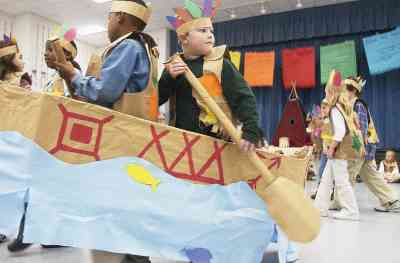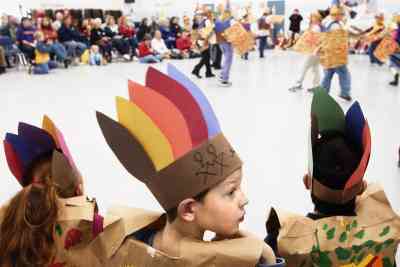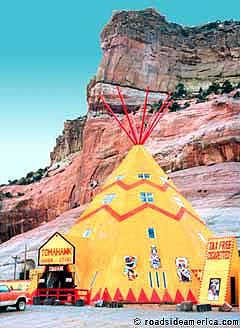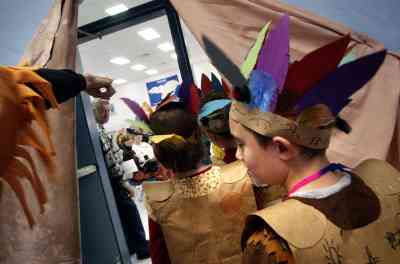 Another Stereotype of the Month entry:
Another Stereotype of the Month entry:
 Another Stereotype of the Month entry:
Another Stereotype of the Month entry:
Stafford school's classes celebrate American Indian culture for Thanksgiving
By KELLY HANNON
Date published: 11/26/2003
Indians did more than bring maize to America's first Thanksgiving.
Second-graders at Ferry Farm Elementary in Stafford County know this. They've spent the past month studying American Indian history, a unit which culminated yesterday in a powwow.
Wearing paper bags fashioned into fringe vests, and crowns of construction-paper feathers, about 100 students filed into the cafeteria to show parents what they'd learned about American Indian poetry, art, culture and dance.
"He's so excited," said Suzanna Stewart of her son, who finally got to demonstrate the powwow step with his class after weeks of practicing at home. "My son's very interested in it. I've been learning a lot about the Indians I didn't know."
Physical education teachers Peggy Scott and Ike Eldridge started the powwow seven years ago, mainly to teach rhythm and eye-hand coordination through traditional American Indian dance.
After the Standards of Learning were introduced, with an accompanying history exam, classroom teachers fleshed out the project with academic lessons.
Second-grade teacher Georgia Arrington said the SOL tests require students to make fairly sophisticated comparisons between three regions of American Indians: Eastern Woodland (Powhatan), Great Plains (Sioux), and Southwestern (Pueblo).
For instance, the students need to know how each region of American Indians lived. The Great Plains tribes didn't have access to trees, so they made homes out of buffalo hide. The Eastern Woodland tribes used bent wood to make longhouses, while Southwestern tribes used mud.
During November, Arrington wedged information about American Indians into every lesson she could, including math.
Using art and multiple mediums to teach a subject, including gym class, helps the information stick, Arrington said.
"What one child can learn from listening and studying, another child can learn from a project," she said.
At the powwow, Arrington's class sang "Colors of the Wind" from the Disney movie "Pocahontas."
The class sang:
"You think you own whatever land you land on/The Earth is just a dead thing you can claim/But I know every rock and tree and creature/Has a life, has a spirit, has a name."

Arrington hopes the American Indian unit has subconsciously taught students to respect one another and the environment, practices most English settlers ignored, she said.
Yesterday, most students were happy just to celebrate culture. They touch-stepped in circles around the cafeteria, reciting songs and clicking sticks on the floor.
If asked to travel back in time, one student knew which tribe he'd belong to.
"Pueblo," said Hunter Keiser, 7, a self-proclaimed future vegetarian. "They eat plants, not meat."
To reach KELLY HANNON: 540/374-5436 khannon@freelancestar.com
To share your thoughts:
http://www.pen.k12.va.us/Div/Stafford/ffes/ffes/ffes.html
Principal Ann Lewis
alewis@staffordschool.net
FERRY FARM ELEMENTARY
20 Pendleton Road
Fredericksburg, Virginia 22405
(540) 373-7366
FAX (540) 371-3788
Response from a Native
A response to this article from DinehWolf:
"Wearing paper bags fashioned into fringe vests, and crowns of construction-paper feathers, about 100 students filed into the cafeteria to show parents what they'd learned about American Indian poetry, art, culture and dance."
This is truly pathetic. Since you claim to study American Indian culture [sic] prior to this event, did you folks sleep through the part which explains that Plains Indian warriors earn these feathers in their warbonnets similar to the way members of the US Armed Forces win their medals? With this in mind, I really have to ask how you go about observing Veterans Day. Do you fashion campaign ribbons out of old paper sacks and have the kids pin them on? Maybe make rank insignias out of old shoe laces or something like this? Or wouldn't you consider this inappropriately disrespectful toward our military?
As for the rest of the rubbish you're teaching these children, where are you digging up all this faulty information? We Navajo are Southwestern Indians, we have wooden hogans and not pueblos, and we're far from vegetarians since mutton is still considered meat. If the nations from the Great Plains don't have access to wood, I certainly wonder how they erect their buffalo hide tepees. Do you suppose they used aluminum poles? What your teachers obviously don't know about Indian cultures would probably fill up the congressional library.

My advice to your school is that next year, you might invite representatives from various Indian nations to teach the children factual information. And please dispense with your three-ring powwow circus as well. Obviously none of your teachers ever bothered to attend a powwow from what I can determine.
Thank you.
The school replies to DinehWolf
Thank you for your concern and e-mail message regarding the article in the Fredericksburg newspaper dated November 26, 2003.
The Virginia Department of Education History and Social Science Standards of Learning, 2.2 and 2.4, for Grade Two are attached in a word document for your information. The History and Social Science Standards of Learning Curriculum Framework amplifies the History and Social Science Standards of Learning and defines the content knowledge, skills, and understandings that are measured by the Standards of Learning tests. The Curriculum Framework provides additional guidance to school divisions and their teachers as they develop an instructional program appropriate for their students. It assists teachers as they plan their lessons by framing essential questions, identifying essential understandings, defining essential content knowledge, and describing the intellectual skills students need to use. This supplemental framework delineates in greater specificity the minimum content that all teachers should teach and all students should learn. The History and Social Science Standards of Learning Curriculum Framework can be found at: http://www.pen.k12.va.us/VDOE/Instruction/History/hist_ss_framework.html
We at the Virginia Department of Education share your desire to educate Virginia students on the American Indian(First American) history and culture.
Again, thank you for taking the time to share your information.
Sincerely, Betsy Barton
Betsy S. Barton
Elementary History and Social Science Specialist
Virginia Department of Education
P.O. Box 2120
Richmond, VA 23218
bbarton@mail.vak12ed.edu
(804) 225-3454
FAX: (804) 786-1703
Rob's comment
I reviewed Virginia's second-grade curriculum. Its categorization of Woodland, Plains, and Pueblo Indians is superficially accurate, but it tends to simplify their lives, make them seem more primitive. For instance, the Pueblo Indians were more than just farmers. At places like Chaco Canyon and Mesa Verde, they accomplished great engineering feats. And their plant life was much more varied than just "cactus." In fact, they used plants adroitly for food and medicine—two key "contributions" that Virginia doesn't note.

More on the kids' comments and costumes:
The Pueblo people weren't and aren't vegetarians. In pre-contact times they hunted animals such as deer and rabbits; now they raise and eat cattle and sheep. True, they were primarily farmers, but that doesn't mean they ate only fruits and vegetables.
These kids (or their teachers) may have confused the Pueblo's peaceful cultures with an abhorrence of killing. If so, it's their mistake.
If any indigenous culture has ever been purely vegetarian, I haven't heard of it. Only modern people have the luxury of adopting a scruple against eating meat. In indigenous cultures, they kill and eat animals—but they usually honor them at the time.
This suggests the problem with "learning" a culture by making costumes and doing dances—by treating it as a game. It's superficial, to say the least. One can easily get the wrong idea—as at least one kid apparently has.
Playing dress-up to learn about Indians is a particularly bad idea. It gives kids the illusion that they can become Indians, or something like them, just by looking the part. But clothes do not make the Indian man (or woman).
That the kids wore phony "fringe vests" and "crowns of construction-paper feathers" suggests the problems with this approach. I don't know which Indians, if any, wore fringed vests, but I don't think the Pueblo or Woodland Indians did. The Pueblo Indians definitely didn't wear crowns of feathers.
These two "fashion accessories" sound more appropriate for Plains Indians—who are the Indians in most people's minds. If the students were studying the Woodland, Plains, and Pueblo Indians, why didn't they dress like these three types of Indians? As far as we can tell from the story and pictures, they're all made up like generic or stereotypical Indians.
That the students participated in a "powwow" (a social function invented in the 20th century) and sang songs from Pocahontas suggests even more problems with this approach. Did they learn any traditional Indian songs? How about modern Indian songs from performers such as John Trudell or Joanne Shenandoah?
The lessons seem to have taught the students that Indians were noble savages or eco-warriors. But some Indians were cruel; some harmed the environment; some owned slaves or fought wars. Did the students learn Indian history and culture in all its complexity and contradictions?
I doubt it. Judging by the article, they got a sanitized, pop-culture version of Native lore. Indians sang and danced, hugged trees, and then mysterious vanished. It's probably not much different from what they'd learn in the Y-Indian Guides.
Related links
Indian wannabes and imitators
|
. . . |

|
All material © copyright its original owners, except where noted.
Original text and pictures © copyright 2007 by Robert Schmidt.
Copyrighted material is posted under the Fair Use provision of the Copyright Act,
which allows copying for nonprofit educational uses including criticism and commentary.
Comments sent to the publisher become the property of Blue Corn Comics
and may be used in other postings without permission.